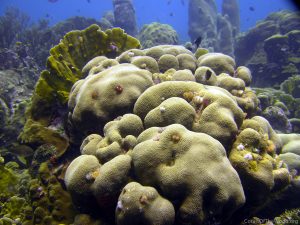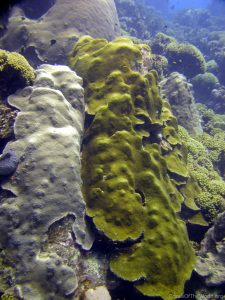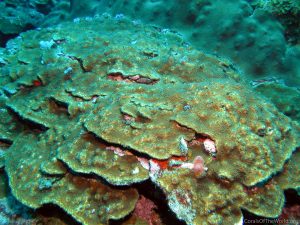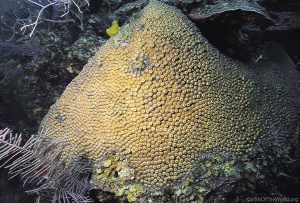BOULDER STAR CORAL Orbicella annularis
on https://www.edgeofexistence.org/:
“Previously known as Montastrea annularis, Orbicella annularis is one of the most dominant species across the Caribbean and Gulf of Mexico where it can form extremely large colonies which vary in morphology.
“Unfortunately this species is also classed as ‘endangered’ due to high population declines. For example, 90% of the coral cover of this species was lost off the coast of Jamaica in 1994. Within the same year this species was split into three distinct species; O.annularis, O.faveolata and O.franksi.
“The considerable morphological variation within this species is characteristic throughout the Orbicella genus and there has such has been much debate over specific taxonomic affinities. The sheer size of the species in this genus makes them ecologically and structurally important additions to coral reefs as they provide refuges for reef dwelling species and can alter microclimates to suit other coral species.”
Corals of the World:
For each species, this site provides a summary description, a distribution map and images. Good images

O.annularis (from Corals of the World)
– Orbicella annularis
Colonies are massive, forming lobed to columnar colonies. Corallites are flattened, of similar size, 2-3mm diameter, formed by extratentacular budding
Colour: Brown or yellowish.
Similar Species: Orbicella franksi has an irregular surface, is more calcified and has more prominent costae. Orbicella faveolata is less calcified, with more uniform corallites with thin costae. Formerly in genus Montastraea.

O. faveolata. From Corals of the World
– Orbicella faveolata
Colonies are massive, forming large rounded domes or columnar, becoming plate-like at edges.
Colour: Brown, grey or yellowish-green.
Well-defined species formerly in genus Montastraea

O. franksi From Corals of the World
– Orbicella franksi
Colonies are massive to plate-like or encrusing with an uneven surface. Corallites are conical and commonly irregular in shape and size,
Colour: Brown, grey or yellowish-green.
Formerly in genus Montastraea.

M.cavernosa From Corals of the World
– Montastera cavernosa
Colonies are massive, forming boulders or domes, or are flat plates. Corallites are variable, but are usually conical and exsert
Colour: Commonly green, brown, grey, or orange
Similar Species: None.
Habitat: All reef environments, especially lower slopes.
Abundance: Common.
Taxonomic Note: A monospecific Atlantic genus, following significant taxonomic rearrangement of numerous other Atlantic and Indo-Pacific species into other genera.
dp: Corallites much larger than in O. annualris
